Sunday, May 12 2024
As most of the USA settles into warmer temperatures this time of year, snakes are slithering out of their dens and becoming  increasingly more active. Snake season has begun! But that’s not all… it’s also time for the inevitable emergence of spiders and scorpions, too! Yikes! But that doesn’t mean we should avoid the great outdoors and stay home. It just means to take common sense precautions and be aware of your surroundings. increasingly more active. Snake season has begun! But that’s not all… it’s also time for the inevitable emergence of spiders and scorpions, too! Yikes! But that doesn’t mean we should avoid the great outdoors and stay home. It just means to take common sense precautions and be aware of your surroundings.
Rattlesnakes usually avoid humans, but about 8,000 people are bitten by venomous snakes in the United States each year, with 10 to 15 deaths, according to the U.S. Food and Drug Administration. One of the best ways to avoid being bitten by a snake is to think about where you put your hands and feet. Look carefully before moving rocks or any object that may be providing shade for a snake. Use caution when walking through fields with tall grass, or along rivers or creeks. Keep in mind snakes are more active in the cooler hours of the day, which means they are more active at night through early morning, so consider installing outdoor lighting fixtures along porches and sidewalks, and carry a flashlight after dark. If you have a backyard swimming pool with a messy log pile next to it and dog food lying out, then you've created the perfect environment to invite rodents, which invites snakes.
Some regions that received more rain than usual this year during the cooler months means there is now plenty of vegetation to feed the rodents and birds that rattlesnakes love to eat. When the ecosystem flourishes, wildlife flourishes, and a number of those birds and rodents are prey to venomous snakes. But that doesn't mean more rattlesnakes now, experts say. That may happen in a couple years, but not until rattlesnakes get fat and happy from plentiful food and make more baby rattlesnakes. As the weather gets warmer, we see snakes come out to sun themselves and look for food, but that doesn’t necessarily mean there are MORE snakes than previous years, it just means all snakes become more active and are therefore seen more often.
Nearly all rattlesnake bites result from human error, not rattlesnake aggression. All rattlesnakes can be aggressive at certain times, but not all rattlesnakes are aggressive in general. Few sounds will make a person freeze or take flight faster than a “rattle,” but since some snakes don’t make that sound, especially baby rattlesnakes, it’s best to assume all snakes are venomous. Although new species of rattlesnakes continue to be discovered, there are currently about 20 species in the United States. The most commonly encountered is the western diamondback; it accounts for the most bites and deaths. They are not aggressive; they're defensive. If you see any type of rattlesnake, don't make it feel threatened and leave a lot of room between you and the snake.
If you are bitten by a rattlesnake or other venomous snake the Mayo Clinic lists these steps:
- Call 911 or go to the nearest hospital as quickly as possible.
- Remain calm and move beyond the snake's striking distance.
- Remove jewelry and tight clothing before you start to swell.
- Position yourself, if possible, so that the bite is at or below the level of your heart.
- Clean the wound, but don't flush it with water. Cover it with a clean, dry dressing.
Be sure NOT to to do these things:
- Don't use a tourniquet or apply ice.
- Don't cut the wound or attempt to remove the venom.
- Don't drink caffeine or alcohol, which could speed your body's absorption of venom.
- Don't try to capture the snake. Try to remember its color and shape so that you can describe it, which will help in your treatment.
Of course your best defense against venomous snakes is not to take a chance in the first place. Wear snake bite protection such as Razer brand lower leg snake gaiters or full Turtleskin brand snake chaps. It’s uncommon for snakes to be active once temps dip below 55°F, but since temperatures like those are months and months away, be safe until then!
Sunday, October 15 2023
Rattlesnakes are most commonly encountered from spring through October, and then they are presumed to hibernate. But that's not exactly true, depending on where you live. Snakes are more reactive to consistently cold weather, rather than a change of seasons. Rattlesnakes are even known to move around during extended warm periods during winter months, especially if they hole up in a stump or other location that can be warmed easily by sunshine. Snakes become sluggish anywhere below 60 degrees° F, so as long as warmer temps prevail, as it seems to be doing this Fall, please be diligent and wear snake gaiters (lower leg protection) w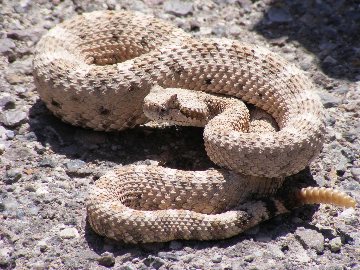 hen outside raking leaves, stacking firewood , hunting, or hiking. A steady temperature drop is a signal for the snake to enter brumation (similar to hibernation), but that’s not nessarily happening yet. hen outside raking leaves, stacking firewood , hunting, or hiking. A steady temperature drop is a signal for the snake to enter brumation (similar to hibernation), but that’s not nessarily happening yet.
Snakes do not actually hibernate, rather they become less active during cold weather. It is called "brumation." Brumation is an extreme slowing down of their metabolism. Snakes are awake, but just very lethargic so you don't see them moving around. In late Autumn, snakes move back to the previous year’s den. If a sudden cold snap catches them before they get there, they may die if not fortunate enough to find a suitable secondary den. They usually do not stay long at the den entrance, but hurry in for the long winter sleep. A number of species may share the same den. For example, black rat snakes, timber rattlesnakes and copperheads commonly den together. Sometimes there will be as many as 100 snakes in one cave. A group site is called a hibernaculum.
Cold-blooded animals like snakes, fish, frogs, and turtles need to spend the winter inactive, or dormant, because they have no way to keep warm. Snakes will crawl into any area free from frost such as caves, hollow logs, holes under trees and stumps, under wood piles, in other animal's burrows, and occasionally in a person's basement, barn, or outbuilding. Snakes will increase their intake of food before brumation occurs, if they can. Not all snakes will survive brumation. A skinny snake will not survive. If the snake feeds heavily before they hibernate, and have digested their meal before the cooling starts, they will be OK. If food is in their stomach or intestines when they cool, it will rot and kill them. Vipers can also brumate during normal conditions, due to a loss of food, but normally when they become dormant it corresponds with extreme temperature changes.
On warmer days in late October and November, early spring, or even during winters, brumating rattlesnakes sometimes come out of their dens to bask in the sunshine. Nice sunny days that follow a long cold snap are often when people are surprised by rattlers. Just like humans, snakes head out to enjoy the sun and unsuspecting hikers can startle them and cause them to strike. Generally, rattlesnakes emerge from their pseudo-hibernation in March or April, or when the average daytime temperatures reach and remain about 60 degrees Fahrenheit (16 degrees Celsius) and higher.
The Centers for Disease Control and Prevention (CDC) estimates that 7,000 to 8,000 people get bitten by venomous snakes each year in the USA (mostly by the Western Diamondback Rattlesnake, Western Pygmy Rattlesnake, Timber Rattlesnake, Cottonmouth, Copperhead, and Coral snake), resulting in 8 to 15 deaths. That number is reason enough to always wear snake gaiters when in the desert or the woods. If you do, you won't have to worry so much about the temperature or the season.
Monday, September 26 2022
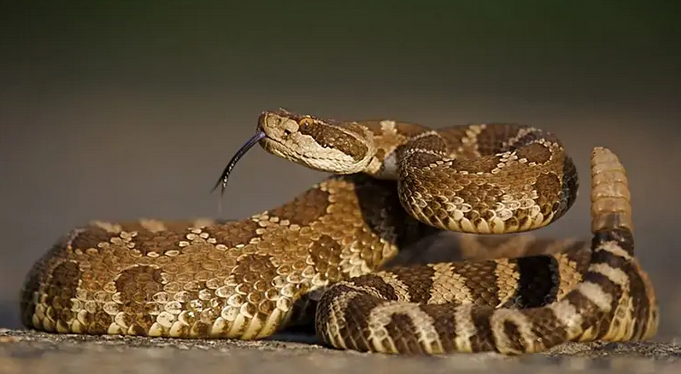 Rattlesnake range is extensive— from southern Canada to central Argentina. The thickest concentration is in the US Southwest and northern Mexico, according to the National Wildlife Federation. The estimated 36 rattlesnake species are adaptable, living in forests, grasslands, swamps and deserts Rattlesnakes are "pit vipers" with heat-detecting pits on their heads. Other US snakes in that family are copperheads and cottonmouths, also called water moccasins. These latter two species are concentrated in the central and eastern United States, whereas multiple species of rattlesnakes range across the United States. Fully grown rattlesnakes are typically between 36 and 46 inches long. Most pit vipers typically deliver a "hemotoxic" venom that attacks the circulation system, destroying blood vessels and causing tissue damage. The only other venomous snakes in the United States are coral snakes. Known for their bright bands of red, yellow and black, they are in a different snake family that's related to cobras. They deliver a neurotoxin that disrupts nerve transmission and can cause respiratory failure and paralysis. Rattlesnake range is extensive— from southern Canada to central Argentina. The thickest concentration is in the US Southwest and northern Mexico, according to the National Wildlife Federation. The estimated 36 rattlesnake species are adaptable, living in forests, grasslands, swamps and deserts Rattlesnakes are "pit vipers" with heat-detecting pits on their heads. Other US snakes in that family are copperheads and cottonmouths, also called water moccasins. These latter two species are concentrated in the central and eastern United States, whereas multiple species of rattlesnakes range across the United States. Fully grown rattlesnakes are typically between 36 and 46 inches long. Most pit vipers typically deliver a "hemotoxic" venom that attacks the circulation system, destroying blood vessels and causing tissue damage. The only other venomous snakes in the United States are coral snakes. Known for their bright bands of red, yellow and black, they are in a different snake family that's related to cobras. They deliver a neurotoxin that disrupts nerve transmission and can cause respiratory failure and paralysis.
Where do snakes hide?
Rattlesnakes constantly hunt for shelter. They hide under logs and in stump holes. They also like woodpiles, thick brush and spaces under boulders, experts say. Pit vipers some times take up residence where people live and work— especially if hiding spots and their food supply (mostly small rodents and lizards) are plentiful. However, rodents are much more likely to get into your house than snakes. If snakes do get into your house, it's most likely you have a rodent infestation. In this respect, rattlesnakes play a key role in balancing the environment. They're mostly eating mice and rats— they're out there doing free pest control.
Do people die from snake bite?
Deaths in the USA from venomous snakes are rare. The US Centers for Disease Control and Prevention estimates about 7,000 to 8,000 people are bitten by venomous snakes in the United States each year. About five of those people die. While human death from a rattlesnake bite is rare, bites will cause a great deal of pain and almost always require a hospital visit to prevent further complications. "The number of deaths would be much higher if people did not seek medical care," the CDC says. World estimates for death by venomous snakebite are much higher -- 81,000 to 138,000 each year.
Rattlesnakes are also afraid of us
Rattlesnakes' reclusive nature is one reason why there aren't more incidents. The rattlesnake actually views humans as a predator; we're a large animal that could eat him. And they're afraid of us, say experts. Rattlesnakes tend to stay hidden. When we encounter a snake on the move, he's usually looking for food or looking for a mate or looking for shelter. Otherwise, he stays hidden because they're so vulnerable to all sorts of predators. Rattlesnakes are "sit-and-wait predators. Some will sit in one place for over a week waiting on a meal. So when there's an encounter, people have generally encroached on their territory.
What to do if a rattlesnake bites you
If you are bitten, seek medical attention as quickly as possible say the experts. If you can, call 911 to come get you. You'll know if you have a serious bite in just a couple of minutes; you can start to feel tingling in your face. According to the California Poison Control System, other symptoms could include:
- Extreme pain and swelling at the bite
- Lots of bleeding
- Nausea, lightheadedness and drooling
- Swelling in the mouth and throat
But what if you can't make that SOS call?
- Keep your heartbeat as low as possible. It takes a while for the venom to work. Don't run, but get yourself somewhere you can make a phone call immediately. There's nothing to really help you from the venom except the serum.
- Stay as calm as possible and deep breathe. Don’t let yourself fall asleep.
- If possible, use a marker or pen and circle where you were bitten in case of swelling. Medical personnel will need to know the bite point.
- Remove jewelry such as rings and tight clothing before you start to swell.
What NOT to do if a rattlesnake bites you
- The best emergency response to a snakebite is car keys and a cell phone!
- Don't employ the out-of-date advice of cut-and-suck (cutting an X at the bite area and sucking the venom out by mouth or suction cups). It's very ineffective; people are likely to do more damage from the knife cut than from the snake bite.
- Do not elevate the affected area! Keep the bite below the level of the heart.
- Don't try to kill the snake to bring to the hospital, and don't take a picture of it unless you can do so easily. Don't comprise your safety by forcing another interaction with an already defensive rattlesnake. Your response to a bite should be the same no matter which type of pit viper bites you.
- Don't apply ice or cold packs to the bite .
- Don't use Advil, Motrin or other nonsteroidal, anti-inflammatory drugs.
- Don’t apply a tourniquet to a pit viper bite. That venom is concentrated and it works like an acid. It breaks down blood vessels and multiple skin tissues. If you confine that venom in that area, you're apt to lose a limb from that. If you allow it to spread, you're more apt to keep your hand or fingers.
How to avoid a snake bite
Rattlesnakes are most active in spring and fall, but vigilance is important all year. Snakes really can venture out in winter on a sunny day. Always be careful where you put your hands and your feet, especially when working around woodpiles or clearing brush. Wear thick gloves. If you're reaching under your house, shine a light under there first to make sure the coast is clear.
- Wear closed-toe shoes or snake proof boots that fangs cannot penetrate. Snake gaiters help protect your lower legs. Snake chaps offer more coverage than just your lower legs.
- Make plenty of noise and vibration while walking. Stick to well-used trails.
- Go around a rattlesnake on a wilderness trail if you spot one.
- If you find a rattlesnake in your yard, call agencies such as your state's natural resources departments or US Fish & Wildlife or contact a biologist at a local college. Do not try to kill the rattlesnake because that's when most people get bit.
- If you must deal with a rattlesnake on your own, use a long branch or pole to gently nudge the snake toward an escape route if you're at least six feet or more away.
- What do you do if you hear that bone-chilling rattle? Experts say if he's rattling, he's alarmed. If you can tell where the snake is, back away. Don't approach. Rattling does not necessarily occur before every bite.
Monday, August 09 2021
Did you know that all 36 species of rattlesnake are native to the Americas? Their overall range stretches from southern Canada to central Argentina, and is concentrated in the American Southwest. They can survive in all kinds of habitats where their prey—birds, rodents, amphibians—is plentiful. Rattlesnakes belong to two genera in the subfamily Crotalinae (the pit vipers): Crotalus, from the Greek word for castanet; and Sistrurus, invoking an ancient Egyptian musical instrument. Both genus names undoubtedly refer to the snakes’ characteristic rattles. More interesting facts about rattlesnakes include: 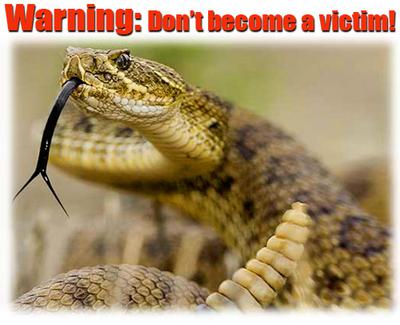
1. Venoms in rattlesnake bites are highly variable—even among members of the same species.
Each type of rattlesnake bite venom out there is an intricate cocktail loaded with different enzymes, toxins, and other compounds. Hemotoxins, which break down capillary walls and hinder blood circulation, are key ingredients in most of them. Neurotoxins, which attack the victim’s nervous system and cause seizures or paralysis, are another weapon. Venom composition can be extremely variable among individuals of the same species; for example, some timber rattlesnakes living in the American South have more neurotoxic venom than their northern counterparts do.
2. Rattlesnakes bite with movable fangs.
Cobras, mambas, and other snakes inject their venom into their victims through a pair of proteroglyphous, or fixed, fangs near the front of their mouths. Those snakes have to bite down and hang on to their prey to deliver the venomous punch. Rattlesnakes take a different approach. Like copperheads and Old World vipers, they have solenoglyphous fangs, which can actually swing forward and allow the rattlers to strike quickly, inject venom, and then back off. When the fangs aren’t being used, they’re pulled back and pressed against the roof of the snakes’ mouths.
3. The eastern diamondback rattlesnake is the largest venomous snake in North America.
Native to the southeastern U.S., the eastern diamondback can grow nearly 8 feet long and weigh more than 15 pounds. It’s the largest rattlesnake on Earth and the biggest venomous snake on the North American continent.
4. Rattlesnakes start growing rattles after their first shed.
Each rattlesnake is born with a nubby scale at the tip of its tail called a pre-button. After the snake’s first shed of their skin, the pre-button gets replaced with a button, a larger, hourglass-shaped scale. Later sheds add hollow, interlocking segments of keratin to the end of the tail. By vibrating the segments, the snakes create its distinctive rattling noise. Although it’s a myth that rattlesnakes must vibrate their tails before striking, they do use their rattles to warn approaching animals or people. Another popular myth suggests that each rattle section represents a year in the animal’s life. In reality, a rattlesnake can shed multiple times, and gain multiple rattle segments, in a single year. Segments can also wear down and break off over time. Crotalus catalinensis, the Santa Catalina rattlesnake, has evolved to be rattle-free. It lives on Isla Santa Catalina, a small island in the Gulf of California. Although it belongs to the same genus as diamondbacks and timber rattlers, the snakes’ ancestors may have lost their appendages because there are fewer predators and big, trample-y mammals on the island to warn with menacing noises.
5. Rattlesnakes don’t lay eggs.
Like anacondas, rattlesnakes are ovoviviparous. This means they produce eggs that hatch inside their bodies and give birth to live, fully formed young. Depending on the species, a rattlesnake litter can include anywhere from one to 25 infants.
6. Rattlesnakes help plants by distributing seeds.
In a 2018 study, researchers looked into the guts of 50 dead rattlesnakes preserved at museums. They found 971 plant seeds that were likely carried by the rodents the snakes had eaten. When a rattlesnake devours some hapless mouse, the seeds it carried in its cheek pouches make their way through the snake’s digestive tract intact. By pooping out the seeds, the snakes help to restore plant growth in its habitat.
7. Benjamin Franklin admired timber rattlers.
Benjamin Franklin thought that rattlesnakes embodied uniquely American diplomacy and toughness. “She never wounds till she has generously given notice, even to her enemy, and cautioned him against the danger of stepping on her,” he wrote in a Pennsylvania newspaper in 1775. “Was I wrong, Sir, in thinking this a strong picture of the temper and conduct of America?” He also noted that, like all snakes, timber rattlers don’t have eyelids, which made them naturally watchful. “She may therefore be esteemed an emblem of vigilance,” Franklin wrote. Rattlesnakes later became symbols of America’s war for independence. Christopher Gadsden, a colonel from South Carolina, designed a personal flag to be flown on five ships belonging to the Continental Army. The bright yellow banner sported a coiled rattlesnake emblem and the caption “Don’t Tread on Me.” It remains popular among advocates of smaller federal government today.
About 7,000 to 8,000 people are bitten each year, but thanks to effective antivenins, most do not prove fatal. Even so, bites are extremely painful, require immediate medical attention, and each vial of snake antivenin costs thousands of dollars! The average snake bite victim requires anywhere from a few vials to dozens of them — it depends on factors like the size of the patient, the potency of venom in the bite and how quickly the patient is treated. The more antivenin needed, the higher the cost— and insurance often doesn’t cover much of it. Why take a chance? Durable, protective snake gaiters for your lower legs, or snake chaps that protect up to your thigh, can be the best defense against rattlesnakes, copperheads, and other pit vipers. Dog snake vests and dog snake neck gaiters can also help keep your furry companions safe.
Saturday, July 10 2021
If you spend a lot of time outdoors and own a dog, chances are your canine best friend goes everywhere with you— hiking, camping, hunting and more. If you have a curious pup who explores anything and everywhere, or a relentless hunting dog who won't quit and will go wherever you send them, you probably worry about protecting him as best as you can when out in the field. 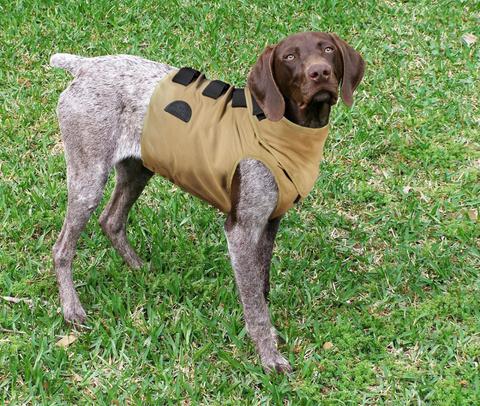
A snake bite directly to your dog's chest or neck can be fatal, so protecting these vital areas while hunting or hiking is critical— and now you can with a dog vest and dog neck gaiter. TurtleSkin SnakeArmor patented technology is produced with the tightest weave ever made. Its high-strength fiber weave is locked so tightly, snake fangs can’t slip past, while the tough ballistic fibers resist breaking. Made from the same material as lightweight Turtleskin SnakeArmor snake gaiters for humans, Turtleskin DogArmor has been tested with actual, live diamondback rattlesnakes, and successfully repelled their strikes and venom. Finally, there is a light and comfortable dog hunting vest and neck gaiter that not only protects from snakes, but from thorns, briars, and sticks, too! Made in the USA.
The layered fabric is also snag free. Flat seams keeps the material smooth so your dog slides through the underbrush with confidence and comfort. Should there be a snake lurking in the grass or woods, you can be sure your dog's chest and belly has the added snake protection necessary. Most snake garments are heavy, stiff, and bulky. TurtleSkin SnakeArmor’s fabric is one-third the weight of other systems, yet tested to repel even large rattlesnakes and cottonmouths.
Snake protection dog vests are available in 2 builds, 5 sizes (Small through XXLarge) and 4 colors (blaze orange, khaki, sage, camo). Builds include “regular” chested dogs and “broad” chested dogs (those with broader chests, bulkier shoulders and thicker necks). Extend the protection afforded by the dog hunting vest by adding a snake protection dog neck gaiter and help keep your canine companion safer. Light weight to keep your pup comfortable all day when out hunting or hiking. Snake bite protection dog neck gaiter is available in from 5 sizes (Small through XXLarge) and 3 colors (khaki, sage, camo).
Upland cover can be brutal on your faithful dog's underside, leaving it red and raw after a day of hunting, but now you can provide chest, belly and neck protection for man's best friend! FOR A LIMITED TIME, get FREE SHIPPING on DOG VEST by using coupon code at check out: DOGVEST.
And don't forget TurtleSkin SnakeArmor Gaiters and TurtleSkin SnakeArmor Chaps and TurtleSkin SnakeArmor Hunting Pants for humans!
Thursday, April 15 2021
Springtime in many states ushers in rain, warmer temperatures, and blooming flowers. You can add something else to that list: snakes. That doesn’t mean you should avoid the great outdoors, but it does serve as a reminder to be extra vigilant about where you step and sit. People have a lot of fear about snakes and think they’re dangerous. If you are harassing a rattlesnake or trying to grab one and they bite you, yes, they can be dangerous. But if you leave them alone, they are not purposely going to attack you. After all, a snake uses its venom for food, not for defense. Most snakes are not outwardly aggressive unless provoked or startled. Some snakes, such at the cottonmouth, are known to be more aggressive than others, but again, that’s only when harassed. Most bites occur when you accidentally step on or near a snake and startle it. That’s easy to do when hiking in tall grass (beware of ticks, too!), dismounting your bike into brush, when landscaping your yard, working around wood piles, cleaning out sheds or barns, or when you are otherwise distracted with a chore and not thinking about where you’re putting your hands and feet.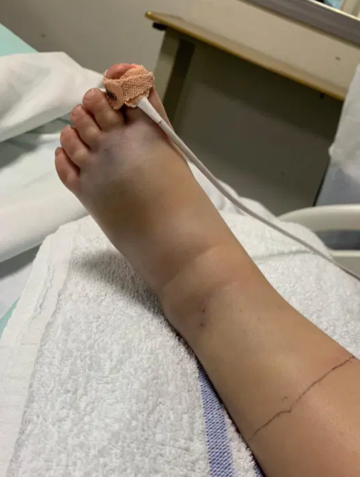
How to identify a rattlesnake:
• The best giveaway is if the snake has a diamond or triangular-shaped head that is wider than its neck.
• Rattlesnakes have chunky bodies rather than longer and slimmer body shapes.
• Rattlesnakes have a white-stripe pattern on their faces.
• Rattlesnakes have vertical eye slits.
How to avoid becoming a victim of snakebite:
• Wear appropriate gear to help block rattlesnake venom if bitten— snake gaiters or snake boots and long pants. Also wear leather gloves if working in snake country.
• Stay on trails when hiking and away from underbrush and tall weeds.
• Never touch a snake, even if it appears dead. Even freshly killed snakes may still be able to bite.
• Look for concealed snakes before picking up rocks, sticks or firewood.
• Never hike or bike alone in remote areas. Have someone with you who can assist in the event of an emergency.
• Teach children to respect snakes and leave them alone.
Did you know that not all snakebites are equal? Some snakes deliver a bite with a small amount of venom and others can deliver a great deal. So-called dry bites contain no venom at all. If you are bitten, even if it doesn’t feel worse than a bee sting at the time, you won’t know how much or how little venom was injected, therefore, it’s imperative you get immediate medical attention. Don’t apply ice, don’t use a tourniquet or constricting band, and don’t attempt to suck out the poison. Constricting blood vessels near a bite can lead to amputation. According to a 2014 report from Texas A&M, a person who suffers a bite from a venomous snake could wind up paying upward of $50,000 in medical bills due to extended hospitalization, treatment for tissue damage, and antivenin treatments. Get to an emergency room as quickly as possible to ensure the best possible outcome!
Sunday, February 21 2021
If there’s one thing worse than actually seeing a rattlesnake, it’s not seeing it and knowing it’s there! Many venomous rattlesnakes are experts at blending into their environment — it’s something wildlife officials and snake removal experts in Arizona see quite often — rattlesnakes that hide in plain sight.
The southwestern speckled rattlesnake from central Arizona is rarely seen by most people because of it's excellent camouflage. In the mountains of southern Yavapai County, the area is covered with rough granite boulders of the same base color as the snake— some pinkish/orange, some black and 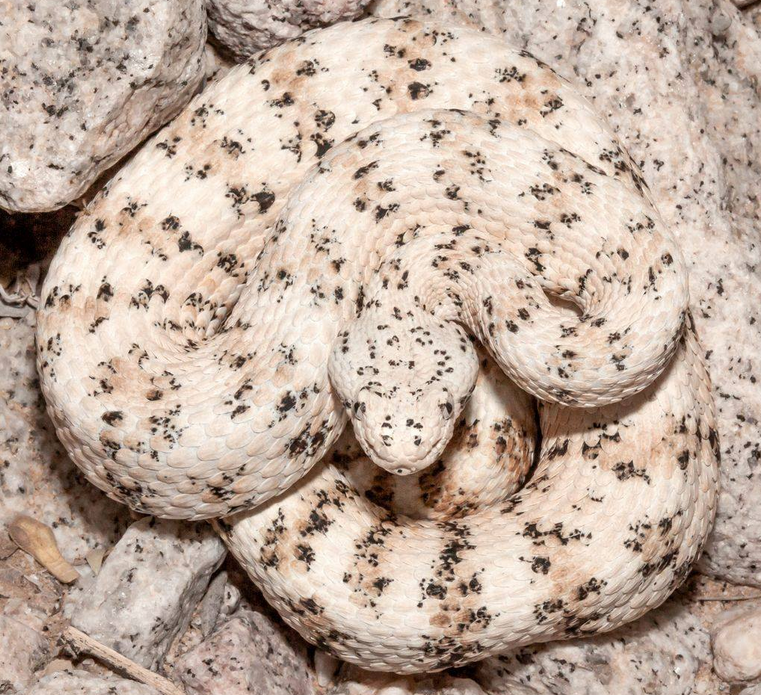 white. There is even a light blue rattlesnake, and you might be surprised to learn this is one of the most common rattlesnake species in the Phoenix area. Each community of southwestern speckled rattlesnakes is born with an adaptation that makes it look almost exactly like the rock composition in its immediate area. To see one in motion is to see what appears to be moving rocks, experts say. Even down to the smallest detail of the eye and the flecking frequency within the rock, the disguise is complete. This makes them both incredibly specialized predators, and notoriously difficult for humans or dogs to spot and then avoid. In the right context, the speckled rattlesnake is nearly invisible to passersby. According to the Tuscon Herpetology Society, this species is found in Arizona, southern California, southern Nevada, and extreme southwestern Utah. Every mountain from Phoenix to the Pacific Ocean has its own unique color combination of southwestern speckled rattlesnakes. Whether you appreciate snakes or they all give you the willies, there’s no denying their impressive camouflage ability. white. There is even a light blue rattlesnake, and you might be surprised to learn this is one of the most common rattlesnake species in the Phoenix area. Each community of southwestern speckled rattlesnakes is born with an adaptation that makes it look almost exactly like the rock composition in its immediate area. To see one in motion is to see what appears to be moving rocks, experts say. Even down to the smallest detail of the eye and the flecking frequency within the rock, the disguise is complete. This makes them both incredibly specialized predators, and notoriously difficult for humans or dogs to spot and then avoid. In the right context, the speckled rattlesnake is nearly invisible to passersby. According to the Tuscon Herpetology Society, this species is found in Arizona, southern California, southern Nevada, and extreme southwestern Utah. Every mountain from Phoenix to the Pacific Ocean has its own unique color combination of southwestern speckled rattlesnakes. Whether you appreciate snakes or they all give you the willies, there’s no denying their impressive camouflage ability.
Encountering a rattlesnake while out hiking or working outdoors is fairly common, but something that’s should not be common is finding a viper hiking under your bed! Yikes! That’s a lot worse than thinking the boogie man lives under there! Recently, a couple in Phoenix were surprised by a big Western Diamondback Rattlesnake. It was nearly 5 feet long — very large for the state of Arizona — and in a “defensive” state of mind. How did it get there? The best guess is that in came in through an open door. The tenant went out onto the patio for a few minutes, left the door open, and then saw it after going back inside from the patio. Only 1 in 400 calls to a rattlesnake removal company proves to be a rattlesnake in a home, showing how rarely it happens. In most of those cases, the rattlesnake got in through an open door. This was safely removed by an expert and good thing, too, because a Western diamondback is one of the nation’s 10 most dangerous snakes, with a venom that causes massive internal bleeding.
Obviously, prevention and avoidance is the way to go when it comes to snakes. So here’s a tip…. don’t plant Lantana around your home. This plant, which is installed at most new builds in Arizona by default, is the most rattlesnake-friendly landscaping feature you can have. If you have it, and live where rattlesnakes do, consider carefully how much you like this type of verbena. Prevention is key. Killing a snake does nothing to prevent future encounters. But not “inviting” snakes in the first place is the way to go. Besides growing lantana, having wood piles, sources of moisture, and rodents can inadvertently “invite” snakes into your yard, too.
If you purposely go out into snake country to hike, bike, camp, or if you work outdoors, don’t take a chance! Snake Gaiters can offer peace of mind and help protect your lower legs from deadly snake fangs.
Friday, September 11 2020
North America is home to dozens of venomous snakes, everything from the small and elusive coral snake in the southern portion of the country, to the much larger timber and diamondback rattlesnakes. But that doesn’t mean you should avoid hunting in snake country. Some of the best hunting grounds for deer, elk, bear, turkey, wild boar, pronghorn, big horn sheep, moose, and other game takes place in areas where poisonous snakes are not just present, but common. If you’ve hunted for any length of time, you’ve no doubt at least seen a snake or two from a distance. Thankfully snake bites are not something that occus every day, but a bite from a venomous species can cause extensive damage and, in some cases, even death. Knowing how to avoid and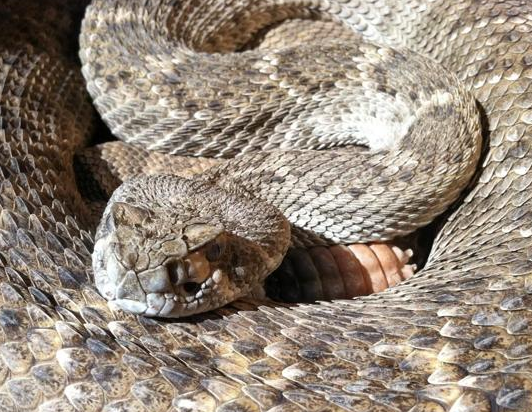 treat a venomous snake bite is a crucial skill for any hunter. treat a venomous snake bite is a crucial skill for any hunter.
Know Something About Snake Habitat and Habits So You Can Avoid Them
A critical first step toward staying safe in areas where poisonous snakes are found is to have a basic understanding of snake ecology. As exothermic animals, snakes must regulate their own body temperature. If it’s cool they will likely seek out a place where the sun’s rays will warm their bodies—on roads, rocks, stone paths, etc. In hot weather, snakes will find spots that are cooler, such as under a fallen log or in a rock pile. Avoid common snake hideouts like deadfalls, tall grass and brush, and rock slides. When you are in the woods, be sure to step on and then over fallen logs and large rocks, and never reach into areas that don’t offer enough visibility to see a snake. The key is to train yourself to recognize potential snake hazards and to avoid them. Most snake bites occur on the hands, lower legs, and feet when someone inadvertently gets too close to an unseen snake. Watch where you sit. It’s true that snakes are most active in the early mornings during the summer months, but snake bites can happen year-round. Stretches of warm weather at any point during the year bring these reptiles out of hiding. Chilly weather often makes snakes more lethargic, but they could be on the move because they are seeking shelter from an imminent cold front. A lesser known fact is that rattlesnakes can only bite from a coiled position. And not all rattlesnakes actually rattle a warning before striking.
Don’t Antagonize Snakes
This should be common sense, but a number of snake bites each year occur because people intentionally put themselves in a position to be bitten. Emergency room doctors report that the most common snake bite victim is male, between the ages of 18 and 35, and the most common place they are bitten is the area between the thumb and forefinger. Usually, there is alcohol involved. Obviously you won’t be drinking if you are hunting, but you get the idea. It’s not a good idea to try and kill a snake you see in the distance. It’s not a good trophy. Snakes are fascinating creatures and you might want to get a closer look out of curiosity, but they deserve a wide berth. When you spot a snake – stop and take a few steps back.
Have the Right Equipment
The most obvious piece of gear you’ll need for hunting in snake country is a pair of snake-proof gaiters or snake-proof boots. In rocky terrain it’s a good idea to have a shooting stick to help you navigate through rough terrain. Sticks accomplish two things. First, they help keep you from falling down into a rock slide or brush pile that may contain a snake, and second, they allow you to stabilize yourself without exposing your hands or legs. Carry a good flashlight in snake country. Communication is key, so if you don’t have a cell phone that works, carry a radio or satellite phone—something that allows you to call for help if you are bitten (or for any other emergency).
Know What to Do if You’re Bitten by a Snake
Avoiding snakes is the best option, but if you are bitten you need to know how to react. The first step is to get away from the snake, making sure that you and others are out of harm’s way. If you can identify the species that may help, but don’t put yourself at additional risk to try and see or catch the snake. There are several myths about sucking venom from the wound, but that’s only Hollywood. Don’t “cut and suck” like in the movies! Prompt medical care is the only reliable option. Increased blood flow spreads venom more quickly, so the first step is to remain calm. Exert as little effort as possible to minimize heart rate and the spread of toxins within your body. Try to keep the bite site below the heart if possible and control breathing. Remove any jewelry like watches or rings because there will be swelling. Cover the bite with something clean, like gauze but don’t put too much pressure on the wound. Every snake bite should be treated as an envenomation (as opposed to a dry bite when the snake strikes but does not inject venom). Get to a doctor as quickly as possible!
Although it’s true that one errant step in snake country can turn a wilderness hunt into a life-threatening emergency, keep in mind that snakes are generally not aggressive unless threatened (by accidentally stepping on or near them) or if deliberately provoked. Given room, they will retreat. If you plan to be trekking through prime snake habitat this hunting season, use these tips to stay safer.
Saturday, June 20 2020
It’s summertime, and like it or not, snakes are out. Last year, several news organizations reported an increase in the number of venomous snake bites in Texas, North Carolina, Georgia, California, and Arizona. Rapid urbanization and higher-than-normal amounts of rain were blamed for the spike in bites, especially since they were occurring more frequently in suburban areas. People can encounter snakes while walking trails, camping or just doing summer yard work. In fact, recent encounters with snakes hiding under car hoods and in pool noodles have made the news. So even if you are sheltering in p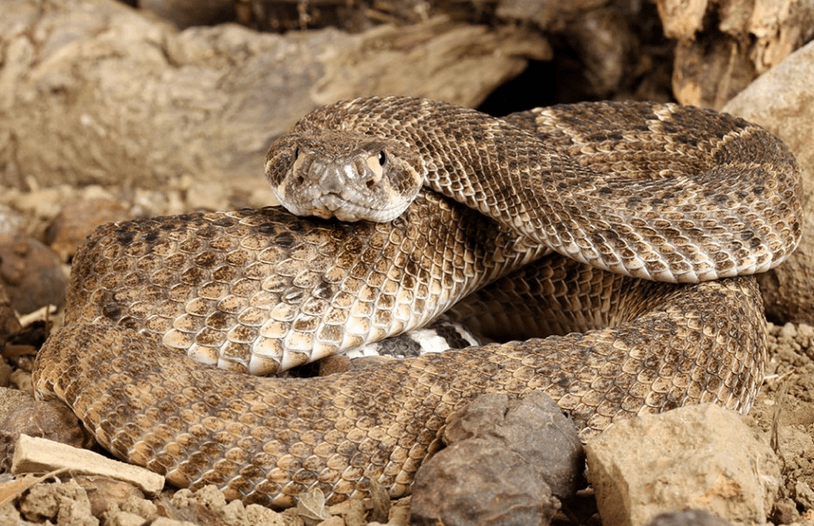 lace due to COVID-19 and not out recreating much, you may still encounter snakes in and around your own home. lace due to COVID-19 and not out recreating much, you may still encounter snakes in and around your own home.
Did you know that there are over 3,000 species of snakes on Earth? While not all of them are perilous, per se, certain slithering serpents are extremely dangerous. Common venomous snakes include western diamond-backed rattlesnakes, copperheads and the cottonmouth, also known as the water moccasin. The range of species and likelihood of an encounter differ from region to region and specific locations. For instance, it’s much more likely to see a cottonmouth around bodies of water, like ponds, lakes or creeks, as well as bottomlands that maintain high levels of moisture throughout the seasons. Although it is best to always avoid contact with all snakes, the Western Diamondback Rattlesnake is probably the most feared. Rattlesnakes are unique to the Americas, with at least 32 recognized species living in a multitude of habitats. Though they are icons of the Southwest, rattlers are found in many states across the country. Part of what makes the Diamondback so deadly is its refusal to back down when partaking in a stand-off. While many snakes are venomous but calm, this desert-dwelling critter can be super aggressive when provoked! This viper coils and rattles its tail (you’ve heard the sound) to warn enemies to stay back. When said enemies don’t take the warning seriously, the sassy snake will strike, and its venom packs quite the punch.
Because snakes are cold-blooded, they prefer sun and/or stretching out on warm surfaces like rocks, pavement and other heat-absorbing materials when temperatures are cooler. Just like people! But in the heat of the summer, they prefer shade, especially from the midday sun. “Contrary to popular belief,” explains a professor of biological sciences at California Polytechnic State University, “rattlers don’t like to be out when it’s really hot. When the temperatures hit triple digits and the monsoon comes, people aren’t the only ones seeking relief. Snakes will hide under something on the ground in people’s yards to get away from that extreme heat.”
What a lot of people don’t know is that venomous snakes typically do not want to use their venom as a defense. They usually give warnings – like rattlesnakes rattling – before they strike. The Texas Department of Health Services reported that half the reported bites by venomous snakes were “dry,” meaning no venom was injected into the victim. Of course victims don’t know that at the time so always seek immediate medical help. A snake strikes because it views you as a threat. Producing venom is an energetically costly process, and they only have so much. If they use it, they must make more to hunt for food, and they have to work for every single meal, so striking to defend themselves is something they would rather avoid.
You can’t get rid of snakes, nor should you necessarily want to. Rattlesnakes can actually do a service to homeowners near the foundation by eating rodents. Learn how to live with them so you, your kids, your pets and the snakes can all be safe. They are integral to ecosystems because they eat insects and rodents you don’t want around the house, in your garage, our outbuildings. Just leave the animal alone if you see one. The Phoenix Herpetological Sanctuary says an estimated 80 to 90 percent of rattlesnake bites occur when untrained people try to move or harm the snake. It’s best to give them plenty of room and let them go on their way. There are no chemical repellants proven to deter snakes, so removing potential shelter and food sources is the best way to NOT attract snakes. Cutting the grass, removing brush and debris, and trimming the lower branches on bushes and trees will go a long way in reducing the places a snake might want to hide. Reducing hiding spots for snakes will also reduce hiding spots for the prey they seek, like rats and mice.
The best advice this summer is as lockdowns are lifted and people get out and about is to be alert and check your surroundings. Wear appropriate protection such as snake gaiters, snake proof boots, or snake chaps, and never purposely disturb or touch a snake.
In the event you are bitten by a snake:
- Remain calm, and move away from the snake.
- Immediately call 9-1-1 or send someone for help and safely transport the snake bite victim to the nearest emergency medical facility for treatment.
- Remove wristwatches, rings or anything constrictive.
- Gently wash the area with soap and water. Keep the bite at or below heart level.
- Try to remember what the snake looked like so you can tell the emergency room doctor (but do not attempt to kill or catch it!)
- Do not cut open the wound and try to suck out the venom. Do not use a tourniquet - this will restrict or cut off blood flow and the limb may be lost.
Monday, March 16 2020
Snakes love warmer days. As reptiles, their body temperature mirrors air temperature, so it’s common to begin seeing many more snakes already this year. In fact, the Scottsdale Fire Department was dispatched to a hiking trail last week to remove a 77-year-old male male suffering from a rattlesnake bite. He was transported to the hospital. Also recently, a Phoenix man was bitten by a rattlesnake while out riding his bike. He pedaled himself to the nearest emergency room and received treatment. Most Arizona emergency departments and hospitals have anti-venom. But there's only a couple of hospitals that have medical toxicologists that specialize in this care. A hospital in the Phoenix area with a toxicology referral center sees 50-75 rattlesnake bite patients annually. Of those, 5-10 people die from the bites. Anyone who gets bit by a rattlesnake should get anti-venom as soon as possible. Wherever the bite is, is where most of the damage is going to occur. And that means breakdown of muscle and skin, as well as a lot of edema and swelling. Each person’s experience will depend on how much venom is injected.
Regardless of the state in which you live, if you work, hike, fish, hunt, prospect for gold, metal detect, ride ATVs, etc. in rattlesnake country, and there is decent numbers, you’re likely going to encounter some snakes this year. Keep in mind that snakes of many species are through hunkering down now that the weather is warmer, making human encounters more likely with ALL types of snakes. You might even see snakes in more northern areas where you’ve not seen them before. “It may have something to do with climate change,” says a wildlife ecologist. “There has been a lot of range expansions of a lot of animals and plants with climate change, and if that continues, they may end up moving north.” For example, Timber rattlesnakes have been found as far north as Red Wing, Minnesota. They find shade under logs and other hidden enclosures during hotter periods of the year.
If you’re wondering how to deal with snakes you might find in your own backyard, keep in mind that nonpoisonous snakes are harmless. They eat mice, rats, and other pesky rodents you don’t want around. Having them near the house is a good thing. When disturbed, these harmless snakes usually just slither away. They prefer to avoid contact with humans. Because you never know what type of snake you might encounter, wear gloves when weeding ground cover around the house. Wear snake gaiters or snake boots when hiking or working around timber.
To avoid accidental encounters with snakes, watch where you place your hands and feet when roaming fields and woodlands, especially in rocky areas. Poisonous pit vipers such as copperheads and rattlesnakes have triangular heads, vertical pupils, and prominent heat-sensing pits between the eyes and nostrils. These characteristics can be difficult to see from a distance, but don’t take a chance — keep your distance. If the snake is within five to six feet of you, make slow movements and move in the opposite direction of the snake. Though copperheads are more common and widespread than rattlesnakes, their bite is much less dangerous. That’s because copperheads are smaller, they deliver less venom, and their venom is weaker than rattlesnake venom. Generally, rattlesnakes are considered the most venomous and the most likely to cause death. Treat any snake bite seriously whether you know for sure what bit you or not! Two (sometimes just one) puncture wounds identify a venomous snake bite. Keep calm and get to the nearest hospital as quickly as possible.
In the warm deserts, rattlesnakes are most active from March through October. In the spring, they are active during daylight hours. As days become increasingly hot around early May, rattlesnakes become more active at night and spend the day in a spot of shade or a cool shelter. Don’t take a chance! Be vigilant and take precautions such as wearing snake bite protection in the form of snake gaiters or snake boots to be safe in snake country— whether that be in the desert or the woods.
|